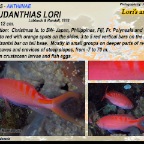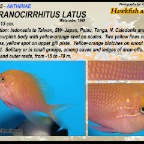Anthias - Anthiinae
ANTHIAS - ANTHIINAE
There are around a hundred different species of this subfamily of the grouper. Anthias are one of the most commonly seen and colorful fish found on a healthy reef. Most of the time they are seen hanging in the current among gorgonia's or other corals that catch a lot of current. Anthias don't live alone, but form large groups of more than a hundred. Everyday they are busy hunting and feeding on zooplankton. Incase of danger or during the night they hide in holes, cracks or between corals. Fully grown anthias are mostly female and live in harems of five to ten females that are protected by one dominant male. When something happens with this male, the most important female will change sex in less than a week and take over the harem. Marine biologists found out that this sex-change is controlled by other dominant males that are bigger and more colorful than the females. Like many other fish they mate just before sunset. All the dominant males will gather above the harems, showing their bright colored dorsal fin. They then start to do a kind of zig-zag dance to entice the females to the surface to spawn. Length: 12 cm.Distribution: From Indonesia to Solomon Islands, S- Japan and Great Barrier Reef.♂ do not have the light orange colour on the back and tailfin, pointy snout and yellowthroat. In large aggregations on outer reef slopes, to depths of -30 m. Primarily on continental reefs.Feeds on planktonic crustaceans and fish eggs. Length: 12 cm.Distribution: From Bali to Vanuatu, Philippines and Great Barrier Reef.♀ with yellow instead of red band on cheek, yellow pectoral fin. In large aggregationsaround coral outcrops of lagoon or outer reef slopes, down to -20 m. Males territorial and haremic. Abundant in Indonesia and Philippines. Length: 20 cm.Distribution: Indonesia to SW- Japan, Micronesia, Samoa, N. Caledonia NW- Australia.Males, from dark orange to magenta with large square violet area on sides. Red spot on rear-tip of dorsal fin. Females, yellow-orange body with yellow fins. Pair of pink stripes from eyes to tail base. In groups, more females than males. On steep seaward reef slopes, from -10 to -180 m. Mostly below -25 m. Length: 19 cm.Distribution: From the Maldives to SW- Japan, Palau, Samoa and Great Barrier Reef.Males, yellowish-pink with red area on forehead. Red and blue diagonal stripe underthe eyes. Red spot on dorsal fin. Females, orange-pink with lavender coloured fins.Tail fin with red tips on lobes. Thin lavender line from eye to pectoral fins. In schools,hovering above the reef or next to gorgonians. Feeds on plankton. Length: 9,5 cm.Distribution: From SW- Japan to Micronesia and Great Barrier Reef.Orange-yellow body with pinkish face, red dorsal fin and translucent tail fin.Male erect dorsal fin during courtship, females are smaller but always outnumber themales. Lives in large plankton-feeding aggregations above substrate, around current-rich areas of steep slopes and reefwalls to - 15 m. Length: 15 cm.Distribution: From the Red Sea to S- Japan, Natal and S.e- Australia.Males have a dark red band on the snout, fine blue margin at the edge of dorsal-,pelvic- and arsefin. Red forehead and tailfin. Females are golden-yellow with red and white band from the eye to the pectoral fin. Males are territorial and haremic. In large aggregations around coral of lagoon or outer reef slopes, from 2 to 20 m.

Anthias info

Pseudanthias huchti - Red cheeked anthias

Pseudanthias dispar - Dispar anthias

Pseudanthias ignitus - Flame anthias

Pseudanthias hypselosoma - Stocky anthias

Pseudanthias pleurotaenia - Squarespot anthias

Pseudanthias squamipinnis - Lyretail anthias

Pseudanthias tuka - Yellowback anthias

Pseudanthias evansi - Yellowback anthias

Pseudanthias lori - Lori's anthias

Pseudanthias smithvanzi - Princess anthias

Serracirrhitus latus - Hawkfish anthias
























